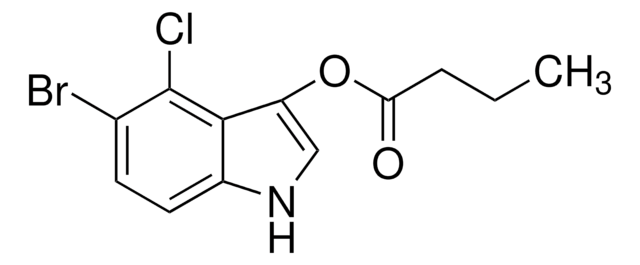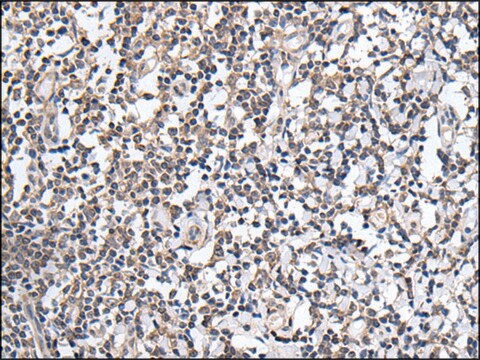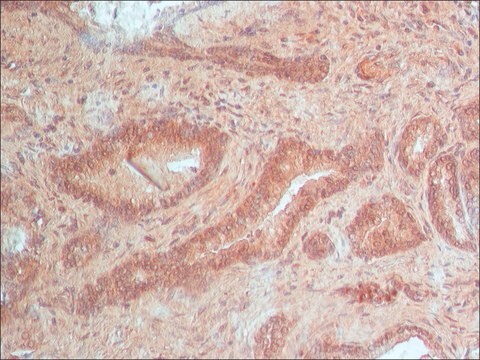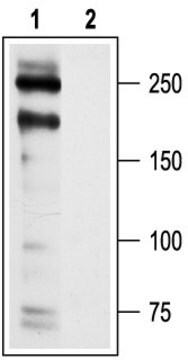MABF1495Z
Anti-NK1.1 (mouse) Antibody, clone PK136, Azide Free
clone PK136, from mouse
Sinônimo(s):
Killer cell lectin-like receptor subfamily B member 1B allele A, Killer cell lectin-like receptor subfamily B member 1C, CD161b, CD161c, CD161 antigen-like family member B, CD161 antigen-like family member C, Ly-55b, Ly-55c, Lymphocyte antigen 55b, Lymph
About This Item
Produtos recomendados
fonte biológica
mouse
Nível de qualidade
forma do anticorpo
purified immunoglobulin
tipo de produto de anticorpo
primary antibodies
clone
PK136, monoclonal
reatividade de espécies
mouse
técnica(s)
activity assay: suitable
flow cytometry: suitable
immunoprecipitation (IP): suitable
Isotipo
IgG2aκ
nº de adesão GenBank
nº de adesão NCBI
modificação pós-traducional do alvo
unmodified
Informações sobre genes
mouse ... Klrb1C(17059)
Descrição geral
Especificidade
Imunogênio
Aplicação
Activity Assay: A representative lot activated target cell killing by cross-linking NK cell surface NK1.1 (NKR-P1C) and target cell surface Fc receptor. Ab-induced redirected lysis (AIRL) assay employing NK cells expressing both NKR-P1B and NKR-P1C prevented NK cell cytotoxicity activation by clone PK136 (Carlyle, J.R., et al. (1999). J. Immunol. 162(10):5917-5923).
Immunoprecipitation Analysis: A representative lot co-immunoprecipitated SHP-1, but not SHP-2 or SHIP, from Swiss NIH mouse-derived MNK-1 pre-NK cells upon upregulating NKR-P1B intracellular ITIM motif tyrosine phosphorylation by pervanadate treatment (Carlyle, J.R., et al. (1999). J. Immunol. 162(10):5917-5923).
Flow Cytometry Analysis: A representative lot immunostained the surface of Jurkat transfectants expressing C57BL/6J (B6) mouse-derived NKR-P1B/CD161b or Swiss NIH (Sw) mouse-derived NKR-P1C/CD161c/NK1.1, but not Jurkat transfectants expressing B6-derived NKR-P1A/CD161a (Carlyle, J.R., et al. (1999). J. Immunol. 162(10):5917-5923).
Flow Cytometry Analysis: A representative lot immunostained NKR-P1B/CD161b-expressing NK cells from Swiss NIH (Sw) mouse strain, NKR-P1C/CD161c/NK1.1-expressing NK cells from C57BL/6J (B6), as well as (B6 3 Sw)F1 cross-strain-derived NK cells expressing both NKR-P1B and NKR-P1C (Carlyle, J.R., et al. (1999). J. Immunol. 162(10):5917-5923).
Note: Clone PK136 is also available in the following conjugated forms for flow cytometry application, APC (MABF1487 & MABF1488), FITC (MABF1489 & MABF1490), PE (MABF1491), PerCP-Cy5.5 (MABF1493 & MABF1494). redFluor® 710 (MABF1496 & MABF1497).
Inflammation & Immunology
Immunological Signaling
Qualidade
Flow Cytometry Analysis: 1.0 µg of this antibody detected NK1.1-positive mouse splenocytes.
Descrição-alvo
forma física
Armazenamento e estabilidade
Handling Recommendations: Upon receipt and prior to removing the cap, centrifuge the vial and gently mix the solution. Aliquot into microcentrifuge tubes and store at -20°C. Avoid repeated freeze/thaw cycles, which may damage IgG and affect product performance.
Outras notas
Informações legais
Exoneração de responsabilidade
Não está encontrando o produto certo?
Experimente o nosso Ferramenta de seleção de produtos.
Código de classe de armazenamento
12 - Non Combustible Liquids
Classe de risco de água (WGK)
WGK 2
Ponto de fulgor (°F)
Not applicable
Ponto de fulgor (°C)
Not applicable
Certificados de análise (COA)
Busque Certificados de análise (COA) digitando o Número do Lote do produto. Os números de lote e remessa podem ser encontrados no rótulo de um produto após a palavra “Lot” ou “Batch”.
Já possui este produto?
Encontre a documentação dos produtos que você adquiriu recentemente na biblioteca de documentos.
Nossa equipe de cientistas tem experiência em todas as áreas de pesquisa, incluindo Life Sciences, ciência de materiais, síntese química, cromatografia, química analítica e muitas outras.
Entre em contato com a assistência técnica








